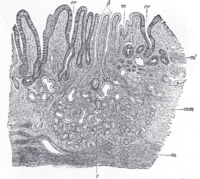
Photo from wikipedia
Background and Objectives: The aim of this in vitro study was to evaluate the effect of simulated gastric acid associated with toothbrushing on the surface condition of three resin-modified glass-ionomer… Click to show full abstract
Background and Objectives: The aim of this in vitro study was to evaluate the effect of simulated gastric acid associated with toothbrushing on the surface condition of three resin-modified glass-ionomer cements (RMGIC). Materials and Methods: One hundred and sixty samples of each material were obtained and included in three study groups according to the tested material: Group I (Ionolux, VOCO GmbH, Cuxhaven, Germany); Group II (Vitremer, 3 M-ESPE, St. Paul, MN, USA); and Group III (Fuji II LC, GC Corporation, Tokyo, Japan). The samples were submersed in hydrochloric acid 0.01 M (pH 3.8) for 3 h and exposed to a toothbrushing procedure at a frequency of 10,000 cycles with medium and hard bristles immediately or 30 min after the acid attack. Profilometric measurements were performed by using a non-contact profilometer (Dektak XT, Bruker, Billerica, MA, USA) in order to assess the surface roughness. ANOVA and Bonferroni post hoc tests were used for the statistical analysis at a significance level of p < 0.05. Results: Exposure of RMGICs to the erosive effect of hydrochloric acid in association with toothbrushing 30 min after the chemical attack increased the surface roughness of all three RMGICs. Exposure of the three tested materials exclusively to the action of hydrochloric acid did not affect the surface roughness. Conclusions: One year of hydrochloric acid challenge associated with one year of toothbrushing with medium-hardness bristles performed 30 min after the acid attack increase the surface roughness of two of the three types of RMGIC tested (Ionolux and Fuji II LC).
Journal Title: Medicina
Year Published: 2022
Link to full text (if available)
Share on Social Media: Sign Up to like & get
recommendations!